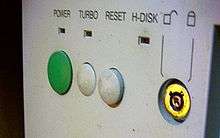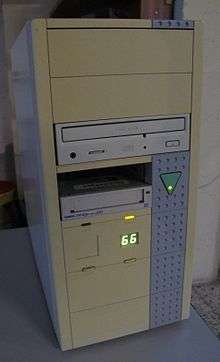Turbo button
On personal computers, the turbo button is a button which provides two run states for the computer: normal speed or an enhanced "turbo" speed. It was relatively common on personal computers using the Intel 80286,[1] Intel 80386 and Intel 80486 processors,[2] from the mid 1980s to mid 1990s.


The name is inspired by turbocharger, a turbine-driven forced induction device that increases an engine's power and efficiency.
Effect
Contrary to what its name suggests, the "turbo" button was intended to let a computer run slower than the speed for which it had been designed.
With the introduction of CPUs which ran faster than the original 4.77 MHz Intel 8088 used in the IBM Personal Computer, programs which relied on the CPU's frequency for timing were executing faster than intended. Games in particular were often rendered unplayable. To provide some compatibility, the "turbo" button was added.
Disengaging turbo mode slows the system down to a state compatible with original 8086/8088 chips.
The average user, who was not relying on outdated software, would have wanted to take care that they always had turbo mode activated, to get the most performance out of their computer.
Switching
On most systems, turbo mode was with the button pushed in, but since the button could often be wired either way, on some systems it was the opposite. On some systems the turbo button was linked to a turbo LED or two-digit segmented display on the system case, although in almost all cases, the indicated frequency (in MHz) wasn't a measure of the actual processor clocks, but the two "fast" and "slow" display options set by jumpers on the motherboard (or a daughterboard linked to the button), or on some later machines, set in the BIOS software.
Some systems also supported keyboard combinations Ctrl-Alt-+ and Ctrl-Alt-- for switching turbo mode on and off; ITT Xtra used Ctrl-Alt-? to toggle.
Some keyboards had a turbo button as well, located near right Shift. Unlike the turbo button that was common on computer cases, the turbo button on the keyboards did not control the clock rate of the CPU; rather, it controlled the keyboard repeat rate.[3]
Use
The feature was relatively common on systems running 286 to 486 CPUs,[4] and rarely on first generation Pentium CPU equipped computers. The MHz displays largely disappeared or were reprogrammed to display "HI"/"LO" when CPU speeds reached 100 MHz, since most systems only had a two-digit display.
As new PC computers continued to get faster and had a wide variety of available speeds, it became impossible for software to rely on specific CPU speed. As software began to rely on other timing methods, turbo became mostly irrelevant to new programs.[5][6]
Software implementations
While the implementation of an actual hardware turbo button has disappeared on modern machines, software developers have compensated with software replacements. One example is DOSBox, which offers an adjustable emulation rate. Modern PCs that support ACPI power management may provide software controls to switch ACPI performance states or other CPU throttling modes. This is used for power saving or to prevent CPU overheating rather than for compatibility because modern applications use the real time clock for timing instead of the CPU clock.
References
- 20-MHz 286 PCs, PC Magazine, June 27, 1989
- Turbo button, Computer Hope, 10-17-2017
- Case, Loyd (2006-05-09). "Keyboards For Less". PC Magazine. Ziff Davis. p. 87. Retrieved 2018-01-07.
When you press the Turbo button simultaneously with one of the first seven Function keys, you can increase or decrease the speed of repeated keys.
- "Eliminate Accidentally Turning Off Turbo Mode on Turbo PCs". Pcguide.com. 2001-04-17. Archived from the original on 2001-04-17. Retrieved 2020-01-14.
- "Turbo Button". Pcguide.com. 2001-04-17. Archived from the original on 2001-07-12. Retrieved 2017-03-04.
- "Electrifying Software For Today's PC". Compute! (advertisement). June 1988. p. 23. Retrieved 10 November 2013. 1988 game advertising automatic compensation for CPU speed.